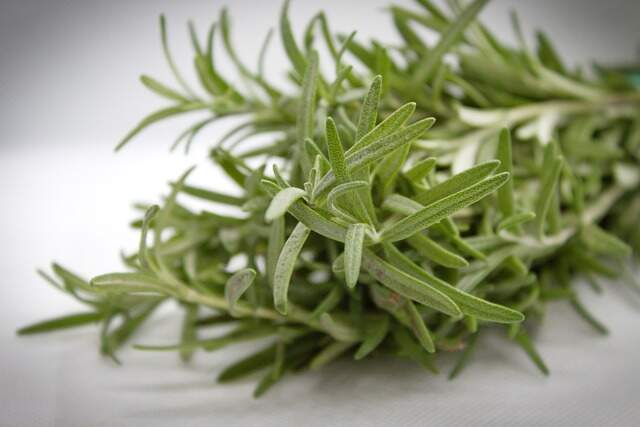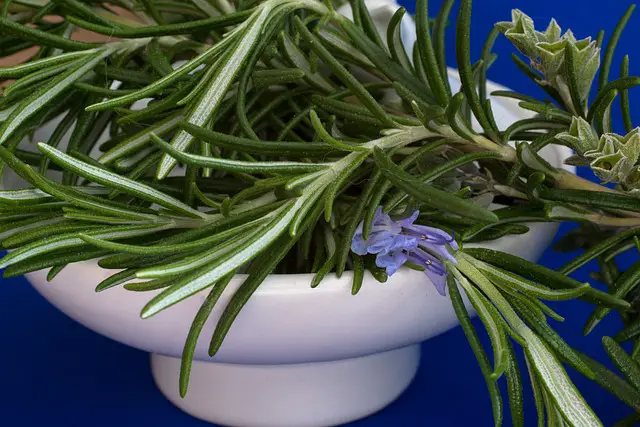How to Grow Rosemary at Home? (A Step-By-Step Guide)

Welcome to our blog on how to grow rosemary at home! Rosemary is one of the most popular herbs used in cooking and its flavor goes with a wide range of foods. Growing rosemary at home allows you to easily access fresh sprigs of the herb for your meals, with minimal effort needed to cultivate it.
In this blog, we’ll walk through all the steps required to make sure your rosemary plant is thriving. Whether you have limited outdoor space or just want to add some green to your interior decor, you’ll learn the tools and tips you need to get started. Let’s begin!
Table of Contents
How to Grow Rosemary at Home?
I. Introduction
A. Benefits of growing rosemary at home
Growing rosemary at home can be both a rewarding and enjoyable experience. Not only does rosemary add flavor and aroma to your favorite dishes, it also provides numerous health benefits. Rosemary is full of antioxidants which have been linked to reduced inflammation, improved cognitive functions and better eyesight.
The herb also has antibacterial and anti-microbial properties that make it effective in treating common illnesses like colds, sinus problems and headaches. Additionally, growing rosemary at home allows you to conveniently use the fresh herbs for cooking or as a decorative accent in your kitchen or garden.
By growing rosemary at home, you’re not only providing yourself with delicious flavors, but also helping improve your overall health.
B. Steps involved in growing rosemary
Growing rosemary at home is an easy and rewarding task. First, it’s important to decide what type of rosemary you want to grow – there are many varieties available, but the most popular with cooks are the Tuscan Blue, Blue Spires and Miss Jessup’s Upright.
Once you’ve selected the right plant for your space, find a sunny spot in your garden or in pots inside, as rosemary needs plenty of sun and well-drained soil. Before planting, ensure that the soil has been enriched with compost or manure.
Plant your seedling deep enough so that most of the stem is below ground level – this will help to keep it healthy for longer. Water regularly, but don’t overdo it; rosemary does not tolerate waterlogged roots and can be prone to fungal diseases if overwatered.
Prune plants regularly to maintain their shape and encourage new growth. Finally, harvest sprigs when needed and enjoy these fragrant leaves in your cooking!
II. Choosing the Right Location
A. Ideal location for growing rosemary
When growing rosemary at home, it is important to choose the right location. Rosemary plants thrive best in full sun and need a well-drained soil to ensure that their roots don’t become waterlogged.
The ideal spot should be sheltered from cold winds, as this can damage the plant and inhibit its growth. Temperatures should also remain between 20 °C and 30 °C throughout the day and never dip below 5 °C at night.
Rosemary will also benefit from regular watering during hot weather, especially if you live in a dry climate. If possible, it’s a good idea to mulch around the base of your rosemary plants to help retain moisture in the soil and keep weeds at bay.
B. How to prepare the soil for planting
When preparing the soil for planting rosemary, it is important to ensure that the location you have chosen receives plenty of sun and has well-draining soil. If your soil does not drain well, add some organic material such as compost or aged manure before planting.
Additionally, mix in a balanced fertilizer with a ratio of 10-10-10 to help promote healthy growth in your plants. To improve drainage further, consider adding an additional inch of coarse sand or rock to the top layer of your soil.
After properly preparing your soil, you are ready to plant and enjoy beautiful rosemary plants right in the comfort of your own home!

III. Planting and Care
A. Step-by-step instructions for planting rosemary seeds or cuttings
For those looking to add a bit of flavor and aroma to their gardens, planting rosemary from seed is an excellent choice. Rosemary is a hardy herb that can be easily grown both indoors and outdoors. The seeds are small, but with the right care and preparation your plants will soon thrive.
Here’s a step-by-step guide for planting rosemary seeds:
Step 1: Start by filling a seed tray or pots with seed compost and watering well.
Step 2: Sow the seeds on the surface, then cover them with a thin layer of compost or vermiculite.
Step 3: Place the tray or pots in a warm place, ensuring that it doesn’t get colder than 15C (60F). If you don’t have access to natural warmth like that of a greenhouse, you can use a propagation mat or cover the tray or pots in plastic bags to keep them warm.
Step 4: Keep the soil moist and wait for germination, which can take up to four weeks. Once your seedlings are large enough to handle, transplant them into 7.5 cm (3in) pots filled with fresh seed compost.
Step 5: When all risk of frost has passed, carefully transplant your young plants into 45 cm (18in) pots if growing indoors, or into their final positions outdoors in well-drained soil in full sun if growing outdoors. The plant will soon become established and reward you with its delicious flavor!
Here’s a step-by-step guide for planting rosemary from cuttings.
Once you have the necessary materials and instructions, planting rosemary from cuttings is a relatively easy process.
Step 1: Begin by taking a cutting in late spring or early summer and removing the leaves from the bottom half of the stem.
Step 2: Dip the cut end in rooting hormone powder and then plant it either in seed compost or a 50/50 mixture of sand and peat moss.
Step 3: Next, keep the soil consistently moist while making sure to place the pot with bright, indirect sunlight.
Step 4: After two to three weeks, check for roots by gently tugging on the stem – if there is resistance, this indicates that roots have formed and your cutting is ready to be transplanted into well-drained soil in full sun.
Remember that these are general guidelines; make adjustments depending on climate conditions as needed for best results!
B. Information on how to care for rosemary plants
Growing rosemary at home is easy and rewarding. The key to keeping your plants healthy is proper care. When it comes to watering, rosemary plants prefer a well-draining soil that doesn’t stay soggy.
Water when the top 1–2 inches of soil feels dry, and make sure you water deeply enough to reach the roots. Feeding your rosemary plant with a balanced fertilizer every two or three weeks during the growing season will help promote healthy growth and foliage.
Finally, pruning can be done by simply trimming back 3–4 inches of new growth throughout the year. Pruning encourages bushier growth and keeps your plants looking neat and tidy. With these simple tips, you’ll have a thriving rosemary garden in no time!
C. Tips for dealing with common problems, such as pests and diseases
When growing rosemary at home, it’s important to take preventative measures to protect your plants from pests and diseases. Start by removing any dead or decaying leaves or stems from the plant, as these can attract insects. If needed, use a mild insecticidal soap spray to get rid of any infestations.
Make sure your pot has good drainage so that the roots don’t sit in soggy soil for too long, which can cause root rot. Provide enough light and water for the plant – too much sun exposure may lead to wilting or drying out, while an excess of water can encourage fungal growth.
Regularly check the plant for signs of stress such as yellowing foliage or stunted growth, and make sure you move immediately if you spot any symptoms of disease. With the proper precautions, your rosemary should stay healthy and happy!
D. Recommended Products for Planting and Care
For Rosemary, you need to purchase Rosemary seeds , fertilizer, and pots or planters. A good fertilizer for rosemary is fish emulsion or a balanced 10-10-10 fertilizer. For pots or planters, I recommend using a 12-inch terracotta plant pot with drainage holes in the bottom.
Additionally, you will need pruning tools such as shears, pruners and loppers to maintain your rosemary plant’s shape. All of these products can be easily purchased on Amazon with just a few clicks.
If you’re in need of a small kitchen windowsill growing set, get the Saratoga Home Herb Pots with Tray Set. Alternatively, if you are receiving very little sunlight in your home, then I would use the Mindful Design LED Indoor Herb Garden .
Lastly, for larger outdoor plants, I personally use the Classic Garden Planters for my Rosemary plants – they have enough room and come with drainage holes at the bottom. So don’t hesitate – start growing beautiful Rosemary today!
IV. Harvesting and Using Rosemary
A. When and how to harvest rosemary
Harvesting rosemary is an important step in the process of growing it at home. The best time to harvest your rosemary is when its leaves are still green, and before they start to dry out or turn brown. Depending on the temperature, this could be anytime from late spring to early autumn.
To harvest, simply pinch off a few stems near the top of the plant and remove them with their leaves attached. You can also snip individual sprigs of rosemary as needed, while leaving enough stem behind so that the plant can continue to grow.
In addition to harvesting for use in cooking and other purposes, pruning back your rosemary plants every few months helps keep them looking healthy and prevents them from becoming too woody and overgrown.
B. Using rosemary in cooking and other home uses
Fresh rosemary adds an amazing flavor to a variety of dishes. Its sharp, piney scent and taste make it the perfect addition to many dishes such as soups, stews, sauces, marinades, roast vegetables, and grilled meats.
Fresh rosemary can also be used for aromatic and decorative purposes in any home; simply place sprigs of fresh rosemary on the dinner table or around the kitchen for added ambiance. Rosemary can also be infused in oil or vinegar; both are great additions to salad dressings.
For drinks like mocktails or cocktails, adding a few sprigs of fresh rosemary to mason jars with your favorite ingredients makes for a unique presentation. Finally, rosemary leaves can be dried out and crushed up into a seasoning mix – ideal for sprinkling over all kinds of meals!
C. Drying and storing rosemary for later use
Once you’ve harvested your rosemary, you may want to dry it so that it can be stored for later use. To dry the sprigs of rosemary, simply hang them upside down in a warm place with good air circulation.
Keep away from direct sunlight and drafts, as this will cause them to lose some flavor and aroma. After several days or weeks, depending on humidity levels, they should be completely dried.
Store your dried rosemary leaves in an airtight container, such as glass jar or plastic baggie, in a cool dark location like a pantry or cabinet shelf. Your dried rosemary can now be used for cooking any time you wish!
D. Recommended Products for Harvesting and Using Rosemary
When harvesting and using rosemary at home, you should invest in the right tools to ensure that your herbs are properly preserved. Drying racks are a great way to dry out freshly-picked rosemary, so it can be stored for future use in teas, rubs, or cooking.
You can find compact ones that won’t take up much space and are easy to store after use. Additionally, airtight jars or containers will also help keep your herbs fresh for as long as possible. Look for items made from glass or ceramic that come with secure lids.
Drying racks and 32 oz. mason jars can easily be found on Amazon with Prime shipping options if you need them quickly! Investing in the right products is key when growing and using rosemary at home, so make sure you find what works best for you and your herb garden.

V. Conclusion
Overall, growing rosemary at home is a simple and enjoyable task that can bring delicious flavor to your favorite recipes. With minimal maintenance and care, rosemary plants thrive indoors or out in moderate climates.
To get started, choose a medium-sized pot with drainage holes filled with well-draining soil and place the plant in an area that receives bright sunlight.
Water regularly but be careful not to overwater and prune the plant occasionally to encourage healthy growth. By following these steps, you’ll have a thriving rosemary plant in no time!
Frequently Asked Questions
Are coffee grounds good for rosemary plants?
Dried coffee grounds are very good for rosemary. It supplies nitrogen to the soil. Do not use brewed coffee grounds because the acidity can harm your plant.
What is the best fertilizer for rosemary?
Rosemary usually grows fine without the need of fertilizers. If you do want to use a slow release shrub fertilizer. My recommendation would be to use it only once, in the beginning of the season, and make sure it’s diluted because it can do more harm than good.
What does overwatered rosemary look like?
Rosemary does not like a moist environment. When rosemary gets too much water the needle tip leaves turn brownish, and water should be scaled back. Check your soil drainage. This is also an early sign of root rot.
How do you keep rosemary from going woody?
To avoid this from happening in the future, here are some steps you can take to keep your rosemary plant healthy: 1) Give your plant an occasional drink of water. 2) Trim off any brown or wilted branches with kitchen shears every two weeks.
How often should rosemary be watered?
Rosemary should be watered every 1-2 weeks. When the weather is very hot it is recommended to water it once a week. Check the top 1-2″ of soil with your finger, if it’s dry water it.
What’s the easiest way to start a rosemary plant?
Many people enjoy growing their own herbs, but don’t know how to start a rosemary plant. The easiest way is by purchasing starter plants from a nursery or garden center. These plants are usually more mature and will grow better than if you started one from seed.
Related Post: 51 Fun Facts About Rosemary (with Photos & Information)










